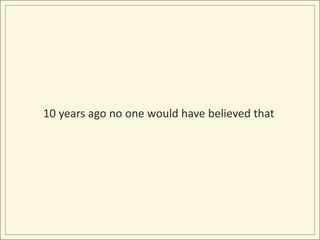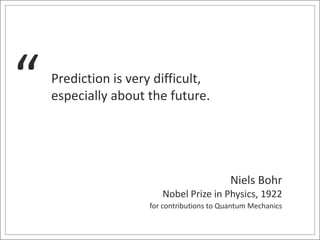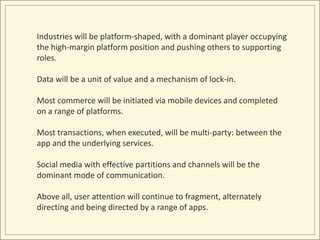The API Tempest
- 1. The API Tempest Leading during a sea change Sam Ramji @sramji VP Strategy, Apigee
- 2. THE TEMPEST
- 3. “ Full fathom five thy father lies; Of his bones are coral made; Those are pearls that were his eyes: Nothing of him that doth fade But doth suffer a sea-change Into something rich and strange. William Shakespeare The Tempest
- 4. APIs challenge every notion of IT – governance, financial planning, team composition, success metrics, security – and many notions of business – secrecy, precise business agreements, locus of control. This is not because of APIs as a technical evolution. This is because APIs are part of the vanguard of the new world of work, the beginning of a 20-year productivity boom that will unsettle traditional hierarchies and business models in an even more pervasive way than the 10-year boom of the Web.
- 5. The new world of work is based on openness: open collaboration, open innovation, and open ecosystems. Underlying this shift are technical enablers: open mobile devices, open networks, open data. APIs themselves may not be the most important angle on this phenomenon, but it is the lens through which we see the entire transformation.
- 7. Technology management is changing.
- 8. From To Data Silos Data Services Governance Curation Waterfall Agile IT Ops DevOps RIM/Blackberry iPhone/Android VPN OAuth Physical Servers Cloud Servers Virtualization Abstraction Requirements Design Browser App
- 9. Business management is changing.
- 10. From To Deal Brokering Self Service Central Planning Edge Innovation Revenue Adoption Control Context Prevention Encouragement Direct Digital Business Indirect Digital Business Major Releases Small Constant Updates Channels Ecosystems Precise Execution Speed and Iteration
- 12. THE FUTURE
- 13. 10 years ago no one would have believed that
- 14. The largest vendor of compute, storage, and networking in the world would be… The world’s largest bookseller.
- 15. Niels Bohr “ Prediction is very difficult, especially about the future. Nobel Prize in Physics, 1922 for contributions to Quantum Mechanics
- 16. Let’s try to look just 5 years ahead through the lens of current macro trends.
- 17. The world will be faster, more connected, with a billion more participants in the global economy. A rising middle class in Brazil, India, China, and Indonesia will adopt devices first and computers second, leaping the digital divide. Gen-Y consumers and employees will be in their 30s, defining the conventions for work and play styles. 4G wireless will be broadly available and 5G will be in limited deployment. Carrier networks will be optimized for traffic against specific services and media types. Consumer devices will be dominant, but small devices for data sensing and processing will make up a significant percentage of mobile and Internet traffic.
- 18. Industries will be platform-shaped, with a dominant player occupying the high-margin platform position and pushing others to supporting roles. Data will be a unit of value and a mechanism of lock-in. Most commerce will be initiated via mobile devices and completed on a range of platforms. Most transactions, when executed, will be multi-party: between the app and the underlying services. Social media with effective partitions and channels will be the dominant mode of communication. Above all, user attention will continue to fragment, alternately directing and being directed by a range of apps.
- 19. Product to Platform Product Subsystem Suppliers Component Suppliers Raw Materials Suppliers Products Consultants Resellers Products Platform Data Products + Data
- 20. This suggests five changes in business
- 21. The fundamental shift from push to pull means that businesses are rewired to focus on the edge. Push was based on a worldview that the smart people who run the company had the answers and needed to push execution down and out to the edge. Pull is based on a worldview that truth is found in the market and that innovation, interaction, and insights come from the edge of the business. The edge must be enabled and information must flow from the edge to the center. Open devices on an open internet are the tools used by the people at the edge of the enterprise. Budgets are growing but CIOs are controlling less, because edge users are choosing their own technology based on the best that is available on the market, not what IT gives them. They buy their own devices and expect them to work. If IT can’t get apps working on those devices, they will develop their own. The consumer is dictating to the enterprise how computing is being done.
- 22. Data is the primary good that flows through the new edge economy. We move from a web economy to a data economy. The nature of data has changed; it is no longer in a database, but in massive streams of small chunks of data moving around. Data needs to be pulled from different places, and the most important place to enable pull is not the enterprise’s employees; it is their customers and partners. Deliver data, not pages. The transition from transaction focus to data focus forces the shift to real-time. Pull economics are based on availability of a good on demand, in response to the request. Customer, employee, and partner attention patterns will reward the most responsive systems. These systems have a weakest link constraint: the whole system is only as fast as the slowest connection. Pull will drive the final stages in the shift from batch to real-time business.
- 23. These changes are global. Global businesses must adapt to this change or perish – either driven out of business by agile competitors or pushed into a lower-value part of their industry by a platform competitor. Single-country players will be decreasingly competitive versus global companies, except where they are protected by regulatory action. The new rule will be extending demand chains and partnering for local and niche delivery of experiences.
- 24. And four changes in technology
- 25. Websites are disintegrating. Why? One billion more people will be using smartphones. Current smartphone users will expand to tablets, readers, connected cars, and smart televisions. Usage shifts towards small devices, multiple operating systems, and small apps exposing slices of functionality all connected to a common backplane. The backplane is data. As websites give way to apps, the common denominator is data, and the point of control is the API. Access, instrumentation, monetization, customization, and scale all center on the API. Data delivery depends on continuously controlled, cached, and customized data availability from underlying datastores. When correctly enabled, this backplane creates the necessary conditions for apps on all devices.
- 26. The API is the point of control. The definition of the API sets a standard for the ecosystem. Each player in the value network writes to the standard, setting software lifecycles on top of the API. While the API may expand over time, the ecosystem hardens around the adoption leader. Apps and devices are disposable, but the API with critical mass is irreplaceable. The competitive advantage is data insight. Business agreements and source code can be duplicated. Algorithms can be reverse engineered. A business that builds a critical mass of customer data relative to competitors can execute a virtuous cycle strategy where each new user and device in the system adds to the velocity of the system’s data growth. This breakaway strategy extends a core advantage – faster global adoption – and builds a new one: data insight. Slices of the data itself produce large-scale dynamic knowledge about the users and actors in its industry which cannot be duplicated, and which can be used for 1st party business optimization or sold to 3rd parties for profit.
- 27. How will the sea change affect your industry?
- 28. How will it rewrite the rules of competition?
- 29. Looking back from 2018, how would you describe the changes and how you led your company to a dominant market position?
- 30. THANK YOU Questions and ideas to: @sramji
Editor's Notes
- #2: Creative Commons Attribution-Share Alike 3.0 United States License






























